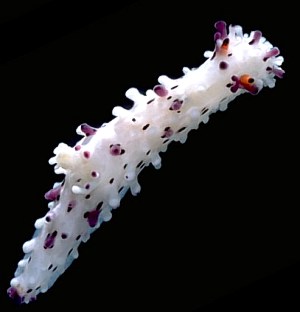
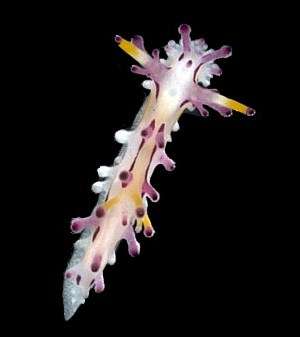
Aegires villosus
Farran, 1905
Order: NUDIBRANCHIA
Suborder: DORIDINA
Superfamily: ANADORIDOIDEA
Family: Aegiretidae
DISTRIBUTION
Widespread Indo-West Pacific species.
PHOTO
UPPER: Edithburgh Jetty, 3m, Yorke Peninsula, South Australia, February 1985. 15mm long alive, AM C145183.
LOWER: Juvenile, 3mm long alive. Lagoon between mainland and Récif de l'Infernet, off Koumac, New Caledonia, 20°34.4'S, 164°13'E, 12m, silty bottom with dense gorgonian beds, 4 October 1993. PHOTOS: Bill Rudman.
The species of the genus Aegires are all small, and feed on calcareous sponges. The purple tipped papillae make this species easily recognisable. Note however from the photos, that in juveniles the papillae are proportionally much longer than in adults.
Reference:
• Farran, G.P. (1905). Report on the opisthobranchiate Mollusca collected by Professor Herdman, at Ceylon, in 1902. In: Report to the Government of Ceylon on the Pearl Oyster fisheries of the Gulf Of Manaar. Suppl. Rep. No. 21: 329-364, Pls. 1-6.
Rudman, W.B., 2000 (January 19) Aegires villosus Farran, 1905. [In] Sea Slug Forum. Australian Museum, Sydney. Available from http://www.seaslugforum.net/find/aegivill
Related messages
Aegires villosus from the Philippines
September 19, 2007
From: James A. Loyola
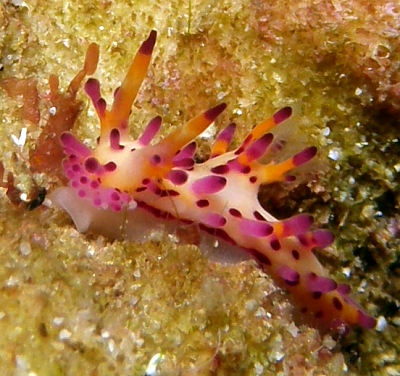
Hi.
Please help me identify this nudibranch I saw last weekend. It was very small and moving at a fast pace. Perhaps Cuthona or Flabellina?
Locality: Ernie's Point, Puerto Galera, Mindoro, 60 feet, Philippines, Pacific Ocean, 15 September 2007, coral rubble. Length: 0.5 inches. Photographer: James A. Loyola.
Thank you
James A. Loyola
jaloyola88@yahoo.com
Loyola, J.A., 2007 (Sep 19) Aegires villosus from the Philippines. [Message in] Sea Slug Forum. Australian Museum, Sydney. Available from http://www.seaslugforum.net/find/20747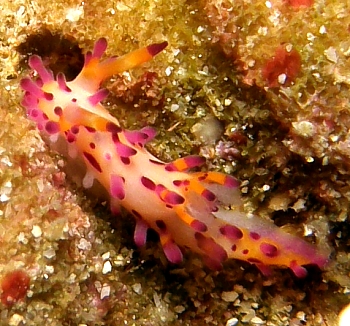
Dear james,
Certainly in colour it looks like some species of Cuthona or Flabellina, and the long tubercles on the back do have similarities to aeolid cerata but this is a dorid nudibranch called Aegires villosus.
One character of most dorids is a circle of feathery gills in the middle of the back. In Aegires they are difficult to see - perhaps camouflaged - but if you look at your upper photo you will see a mound in the middle of the back with some long purple-tipped yellow papillae at the tip. In between these papillae are two or three whitish, almost transparent, feather-like gills
Best wishes,
Bill Rudman
Aegires villosus from Tonga
April 5, 2007
From: Lindsay Warren
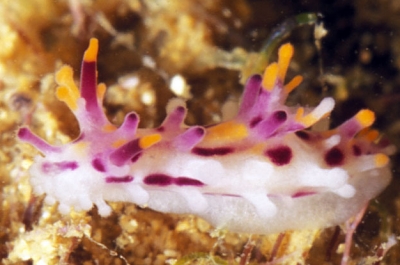
Dear Bill
Just thought you might like to have these shots for a locality record of Aegires villosus from Tonga. Kevin Reed found it while we were rock-pooling in the intertidal zone near Toula village in Vava'u. It was moving in very shallow water along the edge of a fast flowing stream leading from a small lagoon surrounded by mangrove trees. The substrate was a mix of silt covered calcareous algae, bryozoans, etc.
Locality: Toula, Vava'u, 4 cm, Kingdom of Tonga, Tropical Western Pacific, 13 July 2006, 14:05, Intertidal reef crest in fast flowing outflow stream from mangrove lagoon. Reef crest then gives way to sheer wall dropping to approx. 25 m.. Length: 7 mm. Photographer: Lindsay Warren.
All the best
Lindsay
lwarren@datonomy.co.uk
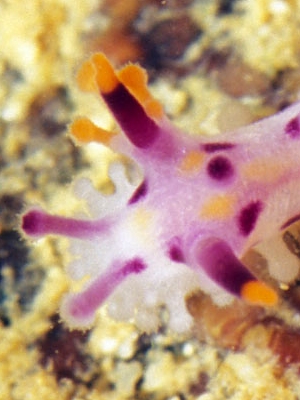
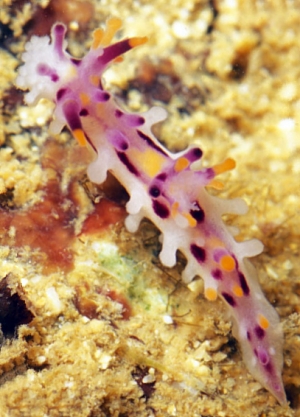
Thanks Lindsay,
It is nice to get records from the eastern most islands of the western Pacific
Best wishes,
Bill Rudman
Aegires villosus ? from Thailand
February 3, 2006
From: Napas Golf
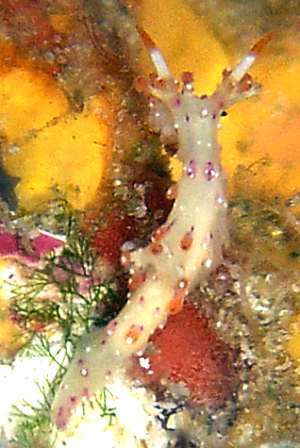
Please kindly indentify these sea slug, found on sponge, rock cave.
Locality: Bon Island/Similan, Thailand, Indian Ocean. Depth: 40 feet. Length: 10 mm. January 2006. Rocky Reef. Photographer: Napas Golf
Napas Golf
napaschon@gmail.com
Napas, G., 2006 (Feb 3) Aegires villosus ? from Thailand. [Message in] Sea Slug Forum. Australian Museum, Sydney. Available from http://www.seaslugforum.net/find/15691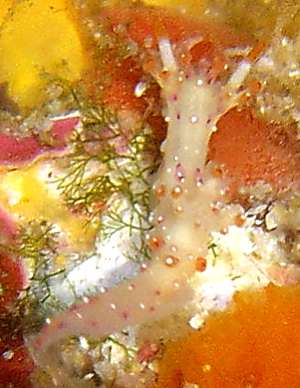
Dear Golf,
Although it's an unusual colour form, I am pretty sure this is Aegires villosus.
Best wishes,
Bill Rudman
Aegires villosus from the Philippines
May 17, 2005
From: Joanne Pun
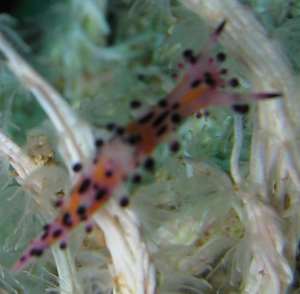
Hi Bill,
Found this tiny furry looking nudi on some almost disintegrated cloth on the reef, hope u can help to identify with my photo attached. Didnt get a good picture as there was a bit of current & this creature is a really tiny for my IXUS500 without macro lens!
Gone thru the whole forum but couldnt even find anything close to it....
Locality: Arthur's Rock, Anilao, Philippines. South China Sea. Depth: 20-25 metres. Length: Abt 1. 5cm. 29 Apr 2005. Reef. Photographer: Joanne Pun
Thanks
Joanne
evil_witch@mail2hell.com
Pun, J, 2005 (May 17) Aegires villosus from the Philippines. [Message in] Sea Slug Forum. Australian Museum, Sydney. Available from http://www.seaslugforum.net/find/13798Dear Joanne,
This is Aegires villosus. The photo is a bit out of focus but I am posting it because it is an example of this unusual yellow-orange background colour
Best wishes,
Bill Rudman
Aegires villosus from South Australia
February 1, 2005
From: Dennis Hutson
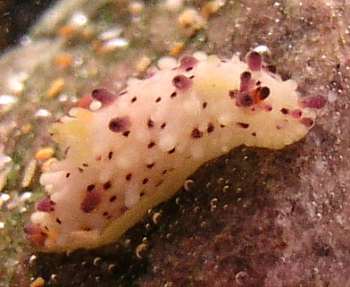
Does anybody know what type of sea slugs this is? I found it under the Edithburgh jetty. It was almost 10 mm. I'm new to this but keen to learn.
Locality: Edithburgh Jetty, South Australia, Depth: 6 metres. Length: 10mm. 23 Jan. 2005. Pylons and rocky bottom. Photographer: Dennis Hutson
Cheers
Dennis.
dghutson@ozemail.com.au
Hutson, D.G, 2005 (Feb 1) Aegires villosus from South Australia. [Message in] Sea Slug Forum. Australian Museum, Sydney. Available from http://www.seaslugforum.net/find/12990Dear Dennis,
This is Aegires villosus. I have a photo of this species from Edithburg Jetty on the species Fact Sheet. This species has a wide tropical Indo-West Pacific distribution and is one of a group of tropical species which is also found in South Australia. It has probably got to South Australia via the Leuwin Current which travels down the West Australian coast and sends a branch east along the south coast. Interestingly, specimens from South Australia seem to be fatter with smaller papillae than their more spectacular tropical siblings.
Best wishes,
Bill Rudman
Aegires villosus from Kapalai
September 5, 2003
From: Mabel Fang
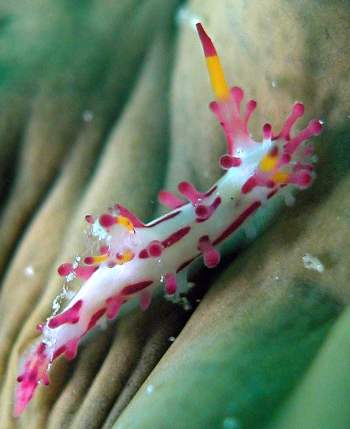
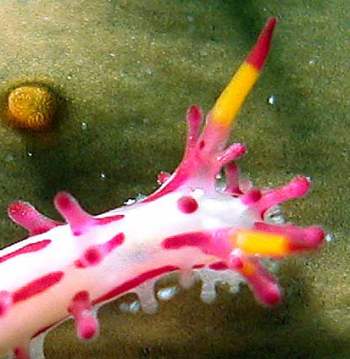
Hi Bill
This unusual spiky nudi was spotted hitching a ride on a green sea cucumber
on a sandy bottom.
Could you kindly identify it for me?
Thanks.
Length: less than 1cm
Depth: 36 ft
Date: 12 Aug 2003
Location: Kapalai, East Malaysia
Regards
Mabel Fang
barramundi@mac.com
Fang, M., 2003 (Sep 5) Aegires villosus from Kapalai. [Message in] Sea Slug Forum. Australian Museum, Sydney. Available from http://www.seaslugforum.net/find/10901Dear Mabel,
Thanks for this nice photo of Aegires villosus. It is a calcareous sponge feeder, so its presence on a large sea cucumber is clearly an error of judgement on the part of the nudibranch.
Best wishes,
Bill Rudman
Nudibranch crawling on a pipefish
December 7, 2002
From: Mary Jane Adams
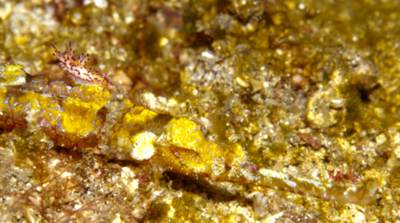
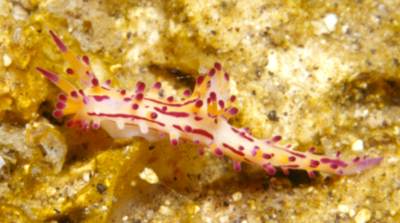
Hi Bill,
While swimming over a low patchy reef in Lembeh Strait last month I came across this strange sight. At first I only saw the winged pipefish resting on the bottom. When I looked through my viewfinder to focus on it, I noticed a little red and white nudibranch crawling along it's back. After one shot the pipefish moved and the nudibranch fell off.
Divesite: Nudi Retreat, Lembeh Strait, Sulawesi, Indonesia.
Depth: 15 meters. Nov. 19, 2002.
The nudibranch was 13 mm long. I don't recognize it. Do you?
Best regards,
Mary Jane
divepng@yahoo.com
Adams, M.J., 2002 (Dec 7) Nudibranch crawling on a pipefish. [Message in] Sea Slug Forum. Australian Museum, Sydney. Available from http://www.seaslugforum.net/find/8621Dear Mary Jane,
This is Aegires villosus. I guess the slug didn't realise where it was.
Best wishes,
Bill Rudman
Aegires - origin of name
March 21, 2002
From: Philip Cromwell
I'm curious: are the family Aegiretidae and genus Aegires named after the Norse and Celtic god of the sea Aegir?
Thanks,
Phil
chiron42@msn.com
Dear Phil,
Many scientific names, especially pre-1900 were based on mythological characters, often classical Greek and Roman, but unfortunately authors often didn't include an explanation for their names when they were first introduced. Considering Loven, the author of Aegires, was Scandinavian, I think you are probably correct in suggesting the name is based on Aegir.
As Thor and Odin are the only northern Gods I have ever heard of I had a quick check for information on Aegir. I see that in Norse mythology he was the god of the seashore and ocean. Although he was feared for causing storms when angry, he was also reknowned for his hospitality as the brewer of beer for the gods, the sea foam being considered homologous with the froth on a glass of beer.
- another vital piece of information to clog my failing neural network
Cheers,
Bill Rudman
Aegires villosus from Bali
March 20, 2002
From: Stuart Hutchison
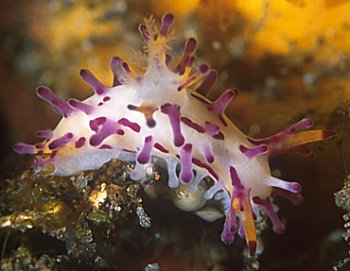
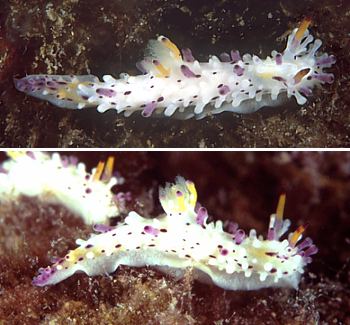
Hi Bill,
This nudibranch [Upper Photo] looks very like Aegires villosus. Found in Bali, Indonesia in Oct 2001, it was around 30mm long from 15m depth.
The two comparison photos [Lower photos] are atrocious scans (subjects from Edithburgh, South Australia in early 2000), but illustrate the similarities. I'll get around to re-scanning the older shots when the RAAF lets me go home to Adelaide!
Regards,
Stuart
stuart@stuarthutchison.com.au
Hutchison, S., 2002 (Mar 20) Aegires villosus from Bali. [Message in] Sea Slug Forum. Australian Museum, Sydney. Available from http://www.seaslugforum.net/find/6296Dear Stuart,
Yes the animal from Bali is also Aegires villosus. This species is essentially a tropical Indo-West Pacific species but it is one of many tropical species which turns up in South Australia not uncommonly. As I mentioned in an earlier message the larvae apparently hitch a ride down the West Australian coast. Can you check the length please? These animals seldom reach 10mm in length so 30mm would be a monster.
Best wishes,
Bill Rudman
Aegires villosus from American Samoa
February 22, 2001
From: Don Barclay
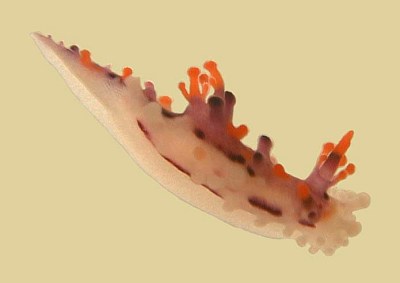
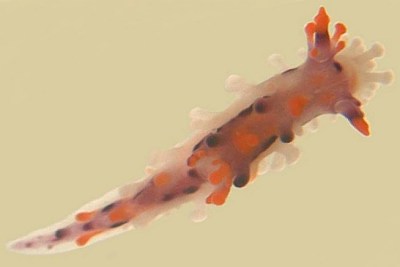
Hi Bill,
Here are a couple of photos of what I suppose is Aegires villosus. It was collected 10 Feb 2001 on the east side of Pago Pago harbor, Onesosopo Point, under a coral boulder in about one meter of water. It was 10mm long, as moved very quickly for such a small slug.
Thanks for all your help, and thanks for making the Forum such a valuable resource.
Cheers,
Don
n5ols@samoatelco.com
Barclay, D., 2001 (Feb 22) Aegires villosus from American Samoa. [Message in] Sea Slug Forum. Australian Museum, Sydney. Available from http://www.seaslugforum.net/find/3788Dear Don,
Thanks for the nice photos which so clearly show the ornate colours and knobs of this species. Without the ability to see each other I sometimes wonder why some of these little animals bother to look so beautiful.
Best wishes,
Bill Rudman
More colour variation in Aegires villosus
March 5, 2000
From: Julie Marshall
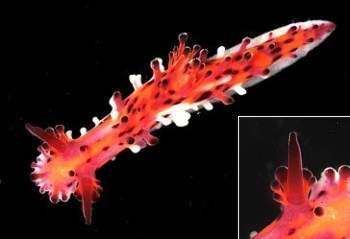
Dear Bill,
Here are some photos of other colour variations of Aegires villosus from Heron Island. This "orange" colour form seems to be the most usual colour form found at Heron Island. It varies in having either completely maroon rhinophores (first photo) or orange rhinophores with maroon tips (second photo). Animals are also found where the major body colour is white. All three animals were 12-13 mm in size and were found in the months of November-December.
Best wishes
Julie
j.marshall@latrobe.edu.au
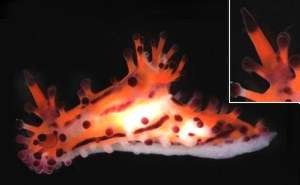
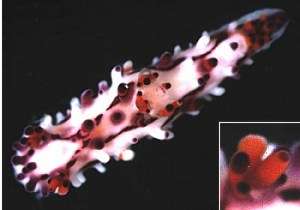
Thanks Julie,
These photos help to give us a better picture of colour variation within the species.
best wishes,
Bill Rudman.
Colour variant of Aegires villosus?
February 27, 2000
From: Scott Johnson
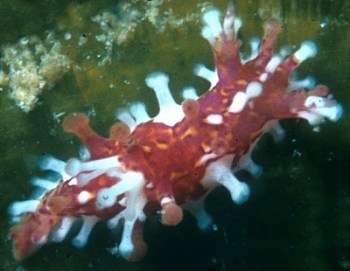
Hi Bill,
Attached is a photo of what I've been calling Aegires villosus from the Marshall Ids. Colors are similar to those figured on the Forum but with less background white showing. All the specimens I've seen here have similar coloration and vary in length from about 5 to 9mm.
Scott
johnson@kmr.ll.mit.edu
Johnson, S., 2000 (Feb 27) Colour variant of Aegires villosus?. [Message in] Sea Slug Forum. Australian Museum, Sydney. Available from http://www.seaslugforum.net/find/1963Thanks Scott,
Certainly more coloured than the A. villosus I have seen, but I guess it could be a colour variant. Has anyone else any colour variations?
Bill Rudman.
Aegires villosus from South Australia
January 31, 2000
From: Stuart Hutchison
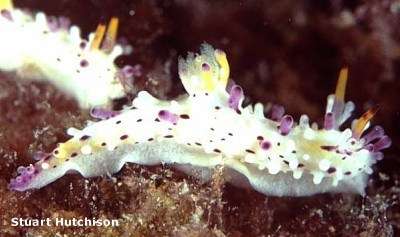
Dear Bill,
Here is another one from Edithburgh, Yorke Peninsula, South Australia, early December 1999 - about 8mm long. Only sighting in five years.
Regards,
Stuart Hutchison.
hutchco@tpg.com.au
Hutchison, S., 2000 (Jan 31) Aegires villosus from South Australia. [Message in] Sea Slug Forum. Australian Museum, Sydney. Available from http://www.seaslugforum.net/find/1754Dear Stuart,
This is Aegires villosus, a small nudibranch which is not uncommon in the tropical Indo-West Pacific. Its presence in South Australian waters again underlines how interesting the fauna of southern Australia is with a good proportion of southern endemic species but also a smattering of tropical species which appear to be recruited as larvae which are carried south down the Western Australian coast by the Leuwin Current. Each year the mix of tropical species in South Australia will change, depending on which larvae fortuitously make the journey south, like Americans to Florida.
Best wishes,
Bill Rudman.
